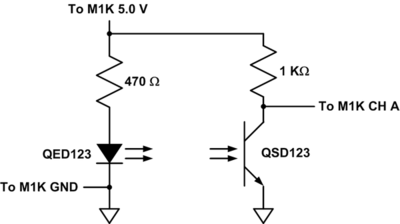Laboratorio M1K Analog Devices: Detector de luz infravermelho
De Wiki Cursos IFPR Foz
Laboratório: Detector de luz infravermelho
Este laboratório foi baseado no material disponibilizado pela Analog Devices, fabricante do módulo educacional M1K Analog Devices: [1]
Objetivos
Conhecer o princípio de funcionamento dos fototransistores e usá-los para construir um detector de luz infravermelho.
Equipamento e Materiais
- Modulo Analog Devices M1K e software Pixelpulse
- Componentes Eletrônicos:
- Resistor: 470 Ω e 1 kΩ
- Led Infravermelho QED123
- Fototransistor Infravermelho QSD123
Procedimentos Práticos
- Monte na matriz de contatos o circuito detector de luz infravermelho da figura, usando o fotodiodo, fototransistor e resistores indicados:
 [1]
[1] - Selecione o canal A do módulo Analog Devices M1K para Medir Voltagem.
- Monitore com o canal A a tensão no coletor do fototransistor.
- Aproxime um objeto opaco entre o fotodiodo e o fototransistor e observe a mudança na tensão no canal A.
Fundamentos sobre Fototransistores
The QED123 LED converts electric current into infrared light and the phototransistor converts the photons impinging onto its base area into an effective base current that controls its collector current. In this lab, the phototransistor is connected in a common-emitter configuration with a 1.0 KΩ collector resistor. Phototransistors can also be operated in common-collector configurations. As the power of the light impinging on the phototransistor increases, the collector current increases, causing the collector voltage to drop due to the voltage drop across the collector resistor. The collector current reaches an upper limit when the phototransistor enters its saturation region in which the collector-emitter voltage VCE reaches approximately 0.2 V and the remaining voltage drop from the 5.0 V power supply appears across the collector resistor. Any further increase in light power applied to the phototransistor will not increase the collector current any more beyond this point. The phototransistor includes a dark plastic daylight filter that filters out most visible lignt, allowing it to operate in environments with considerable ambient visible light without producing a significant DC current error. The photodiode also has a very low “dark current,” which is defined as its collector current with zero light applied light power. When the light form the QED123 LED is blocked from being applied to the phototransistor, the collector current becomes negligible and the voltage drop across the collector resistor is zero for the practical purposes of this lab, and the entire supply voltage appears at the collector.
Observações e Conclusões
Referências
Evandro.cantu (discussão) 16h30min de 14 de julho de 2020 (-03)